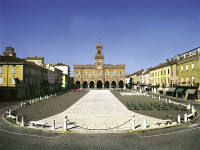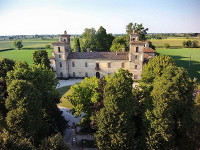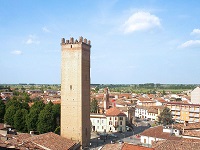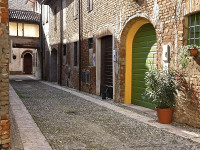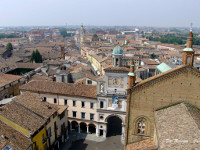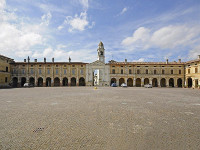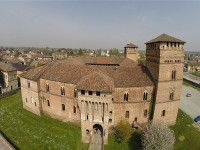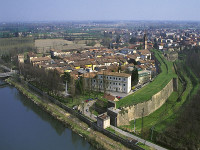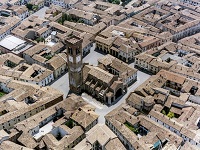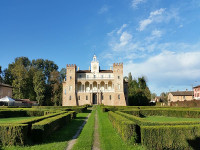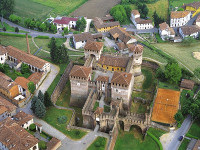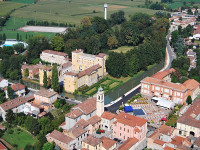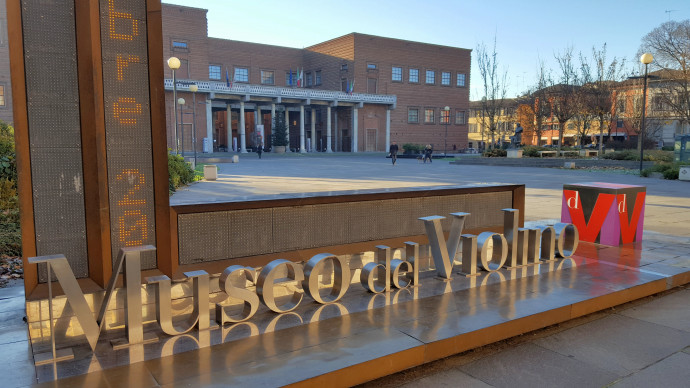- Itinerari
ALONG CREMONA’S CANALS
From Cremona to Crema and Spino D’Adda
The route includes some protected bike-lanes (80%) and some secondary roads with very little traffic.
It goes through the Northern-Western area of Cremona’s Province, along the towpaths of the Naviglio civico di Cremona (14th Century) and of the Canale Vacchelli (19th Century) which, in two different moments of Cremona’s history, contributed to the irrigation of the Northern part of Cremona’s province. Attention: the banks of the canals are not protected. Please ride your bike carefully and stay away from the canal’s edge.
Out of Cremona, the first village you can visit is Casalbuttano. In the 19th Century Casalbuttano based its economy on the manufacturing activities, in particular the reeling factories employed more than one thousand workers. For this reason, it is called the ‘little Italian Manchester’. The ex-spinning mill Turina, which is a residence nowadays, still maintains some original facilities, like the huge manufacturing room where are regularly organized some artistic exhibitions. The hearth of the small village is the big Libertà Square with its buildings of the 19th Century and the S.Giorgio Curch which is full of artistic masterpieces by important local painters. Then there is the famous bell tower (65m): it is the second highest in Cremona’s Province after the famous Torrazzo. Another important attraction is the “Norma Tower”, explained in the variant 1.
Genivolta is very important too. This rural village lies on the high bank of the Oglio river. Genivolta represents a fundamental point for the territory. Few kilometres far from the centre of the village you can find the point where the rivers Oglio, Adda and Serio mix their water together and then separate again to find new ways. Big streams, like the Naviglio Civico di Cremona, the Naviglio Grande Pallavicino and the Canale Vacchelli, or thousands of small streams which go through the entire countryside to take water to the fields. The system was improved year after year and, nowadays, the leakages are very few. In Spring the flowing water offers a wonderful natural show.
Wherever you look you are surrounded by flowing water. The little village “Tredici Ponti” represents the point where the streams coming from Tomba Morta go under the ex-state-road 498 ‘Soncinese’.
Crema, with its medieval historic centre, was influenced by the rule of Venice for more or less 400 years. We recommend a visit to the Cathedral’s Square (with all its monuments) and to the different noble and elegant palaces. It is worth a visit also the ex-nunnery S. Agostino, whose dining hall was painted in the 16th Century by Giovanni Pietro da Cemmo. The Sanctuary Santa Maria della Croce dates back to the Renaissance and it is full of important frescoes and altarpieces. The route ends in Spino d'Adda, where it is connected to the Adda itinerary of “Music in the Wind”.
VARIANT 1a - “MUSICAL” ROUND TRIP: Cremona–Paderno Ponchielli-Casalbuttano
Cremona, famous for its music and for its important violin-making tradition, is the starting point of a round-trip which goes trough some interesting villages.
Amilcare Ponchielli, the famous composer, was born in Paderno Ponchielli in 1834. A gravestone dedicated to the author of “I Lituani” and of “La Gioconda” reminds us about him and his life. The gravestone is on the facade of the Town Hall. A museum rich of musical instruments was founded in Ponchielli’s birth-house.
Also Casalbuttano can boast a curious link with the music: not only because in its church there is one of the biggest organs in the province, made in 1831 and then enlarged in 1892, but especially because in Casalbuttano used to live, more or less in 1830, Vincenzo Bellini. His stay in the village was very happy, not only for his musical career but also because here he had a passionate love affair with the wife of the landowner Ferdinando Turina. Because of this love affair the woman, Giuditta Cantù, was repudiated by her husband. The highest tower in Casalbuttano was constructed by the Turina family after this event and the citizens of Casalbuttano call it the “Norma Tower”, in memory of the famous artist from Catania. This neo-Gothic construction is located in the middle of a park, surrounded by other neo-Gothic pavilions and by the remains of the ancient stables.
The theatre is dedicated to Vincenzo Bellini and it proposes a regular season of events.
VARIANT 1b - ANTICA STRADA “REGINA”: from Cremona to Soresina
The name “Antica Strada Regina” derives from a Roman road which used to connect the Castrum Cremonensis to Milan. The route starts ideally in the Cambonino Neighbourhood in Cremona and it ends in Soresina, where it is possible to take the cycling route Ciclabile delle Città Murate. There are also on this route several interesting points of interest, starting from the Castle Breda de Bugni in Castelverde.
The building, which dates back to the 14th Century, is similar to an incomplete fortress characterized by two towers dating back to the Middle Ages (on the front). With a ditch and a drawbridge it presents a Renaissance loggia which offers a view on the inner courtyard. Immediately after, in Annicco, we can admire the Castle where Cabrino Fondulo, a famous lord and captain from Cremona, was betrayed by one of his relatives in 1425 and then kidnapped by the troops of Filippo Maria Visconti. The building was almost completely restored and today it is a seat of the Town Hall. It has a neo-Gothic style. Morever, in Grontorto, you can’t miss the remains of an ancient castle, recently restored, which dominates the territory from a hill.
For further information about Soresina please have a look at the route number 3.
VARIANT 1c - THE CASTLES IN CREMA’S AREA: Crema–Pandino–Gradella
The variant abandons the route 1 in Palazzo Pignano, a special and unexpected village. Here it is possible to visit the Antiquarium, the Romanic Parish Church, the ancient church of the 5th century, the remains of the 6th and 7th Century village and the archaeological area of the Roman villa where are regularly carried out important excavation campaigns. Not very far, the castle of Pandino represents one of the most important examples of the 14th century fortified architecture of the Visconti family.
Built more or less in the middle of the 15th Century, as a hunting residence of the lords of Milan, it has a square plan with four towers which close a wide courtyard with big arcades on the ground floor and colourful decorations on the upper one.
Gradella is a small village 1 km far from Pandino. It is considered one of the most beautiful villages in Italy because of its block of houses with arcades and loggias along the entire plan.
In this rural village there are some houses painted in yellow with a framework of red bricks.
It is possible to visit the church, the graveyard with a small Chappel and especially villa Maggi which dates back to the 17th Century and it is painted in red with a framework of yellow bricks (the contrary of the other houses).
In Trescore Cremasco there is the famous Sant'Agata Church. Among the best monuments of Crema’s territory, the Church has a facade made in bricks which respects the baroque style. Inside of the church there are a lot of wonderful frescoes. In Torlino Vimercati the Sant'Ambrogio Church (the only one dedicated to the Saint of Milan in Crema’s diocese) dates back to the 16th century but it was then restored. Inside of it there are some interesting artworks like the paintings by Tommaso Pombioli and Gian Giacomo Barbelli. It is worth a visit also Villa Marazzi, an interesting villa in the 20th and 19th century style, and then villa Vimercati Groppallo Castelbarco, an aristocratic summer house with a yellow facade with a red framework; the inner part is in neoclassic style and it has a big garden.
Mostra cosa c'è nelle vicinanze:
